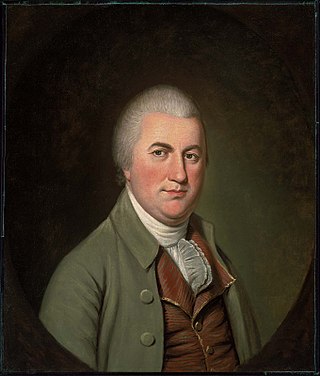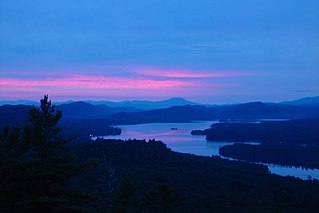Related Research Articles

Wayne County is a county in the U.S. state of New York. As of the 2020 Census, the population was 91,283. The county seat is Lyons. The name honors General Anthony Wayne, an American Revolutionary War hero and American statesman.

Mendon is a town in Monroe County, New York, United States, and has been ranked as the most affluent suburb of the city of Rochester. As of the 2020 United States Census, the population was 9,095.
Bloomfield is a village in Ontario County, New York, United States. The population was 1,361 at the 2010 census.

Nathaniel Gorham was an American Founding Father, merchant, and politician from Massachusetts. He was a delegate from the Bay Colony to the Continental Congress and for six months served as the presiding officer of that body under the Articles of Confederation. He also attended the Constitutional Convention, served on its Committee of Detail, and signed the United States Constitution.

Pittsford is a town in Monroe County, New York. A suburb of Rochester, its population was 30,617 at the time of the 2020 census.

Upstate New York is a geographic region consisting of the area of New York State that lies north and northwest of the New York City metropolitan area. Although the precise boundary is debated, Upstate New York excludes New York City and Long Island, and most definitions of the region also exclude all or part of Westchester and Rockland counties, which are typically included in Downstate New York. Major cities across Upstate New York from east to west include Albany, Utica, Binghamton, Syracuse, Rochester, and Buffalo.

The Holland Land Company was an unincorporated syndicate of thirteen Dutch investors from Amsterdam, headquartered in Philadelphia, who purchased large tracts of American land for development and speculation. Their primary purchase was that of the western two-thirds of the Phelps and Gorham Purchase in 1792 and 1793, an area that afterward was known as the Holland Purchase. Additional lands were purchased in northwest Pennsylvania. Aliens were forbidden from owning land within New York State, except by special acts of the New York State Legislature, so investors placed their funds in the hands of certain trustees who bought the land in central and western New York State. The syndicate hoped to sell the land rapidly at a great profit. Instead, for many years they were forced to make further investments in their purchase; surveying it, building roads, digging canals, to make it more attractive to settlers. They influenced state policy in New York to allow foreign ownership of the land, avoid new taxes, and promote the construction of the Erie Canal and government roads on the company lands. They supported Governor Dewitt Clinton's faction in the state government to achieve these goals. The company finished selling its New York lands in 1839 and its Pennsylvania lands in 1849, and the company was liquidated in 1858.

The Phelps and Gorham Purchase was the purchase in 1788 of 6,000,000 acres (24,000 km2) of land in what is now western New York State from the Commonwealth of Massachusetts for $1,000,000 (£300,000), to be paid in three annual installments, and the pre-emptive right to the title on the land from the Six Nations of the Iroquois Confederacy for $5000 (£12,500). A syndicate formed by Oliver Phelps and Nathaniel Gorham bought preemptive rights to the 9,600-square-mile (25,000 km2) parcel - larger than six present U.S. states: Vermont, New Hampshire, New Jersey, Connecticut, Delaware, and Rhode Island - in New York, west of Seneca Lake between Lake Ontario and the Pennsylvania border, from the Commonwealth of Massachusetts.

Oliver Phelps was early in life a tavern keeper in Granville, Massachusetts. During the Revolution he was Deputy Commissary of the Continental Army and served until the end of the war. After the war ended, he was appointed a judge, was elected to the U.S. House of Representatives, and became a land speculator in western New York state. A depressed real estate market forced him to sell most of his holdings.

Western New York (WNY) is the westernmost region of the U.S. state of New York. The eastern boundary of the region is not consistently defined by state agencies or those who call themselves "Western New Yorkers". Almost all sources agree WNY includes the cities of Buffalo, Niagara Falls, Jamestown, and the surrounding suburbs, as well as the outlying rural areas of the Great Lakes lowlands and Niagara Frontier, and Chautauqua-Alleghany. Many would also place Rochester and the Genesee Valley in the region while some would also include the western Finger Lakes within the region. Others would describe the latter three areas as being in a separate Finger Lakes region.

The Buffalo River drains a 447-square-mile (1,160 km2) watershed in Western New York state, emptying into the eastern end of Lake Erie at the City of Buffalo. The river has three tributaries: Cayuga Creek, Buffalo Creek, and Cazenovia Creek.

This article documents the history of Rochester, New York, in western New York State. Settlement began in the late 18th century, and the city flourished with the opening of the Erie Canal. It became a major manufacturing center, and attracted many Italians, Germans, Irish and other immigrants, as well as a dominant group of Yankees of New England origin. The Yankees made Rochester the center of multiple reform movements, such as abolitionism and women's rights. It was famous as the center of the American photography industry, with headquarters of Eastman Kodak. In the 1970s it became fashionable to call the industrial cities along the Great Lakes 'rustbelt cities' following the move away from steel, chemical and other hard goods manufacturing. Rochester, with the presence of Ritter-Pfaulder, Bausch and Lomb, Eastman Kodak, Xerox, Gannett and other major industries, defied the trend for many decades following WWII.

The Preemption Line divided the aboriginal lands of western New York State awarded to New York from those awarded to Commonwealth of Massachusetts by the Treaty of Hartford of 1786. It was defined as the meridian (north–south) line from the eighty-second milestone of the Pennsylvania–New York survey line at 76° 57' 58" W northward to Lake Ontario.

Charlotte is a neighborhood in Rochester, in the U.S. state of New York, located along the western bank of the mouth of the Genesee River along the southern shore of Lake Ontario. It is the home of the Port of Rochester and Charlotte High School.

The Treaty of Fort Stanwix was a treaty finalized on October 22, 1784, between the United States and Native Americans from the six nations of the Iroquois League. It was signed at Fort Stanwix, in present-day Rome, New York, and was the first of several treaties between Native Americans and the United States after the American victory in the Revolutionary War.
The Treaty of Big Tree was a formal treaty signed in 1797 between the Seneca Nation and the United States, in which the Seneca relinquished their rights to nearly all of their traditional homeland in New York State—nearly 3.5 million acres. In the 1788 Phelps and Gorham Purchase, the Haudenosaunee (Iroquois) had previously sold rights to their land between Seneca Lake and the Genesee River. The Treaty of Big Tree signed away their rights to all their territory west of the Genesee River except 12 small tracts of land for $100,000 and other considerations. The money was not paid directly to the tribe, but was to be invested in shares of the Bank of the United States, and to be paid out to the Senecas in annual earnings of up to six percent, or $6,000 a year, on the bank stock.
Fellows v. Blacksmith, 60 U.S. 366 (1857), is a United States Supreme Court decision involving Native American law. John Blacksmith, a Tonawanda Seneca, sued agents of the Ogden Land Company for common law claims of trespass, assault, and battery after he was forcibly evicted from his sawmill by the Company's agents. The Court affirmed a judgement in Blacksmith's favor, notwithstanding the fact that the Seneca had executed an Indian removal treaty and the Company held the exclusive right to purchase to the land by virtue of an interstate compact ratified by Congress.
The Treaty of Hartford is a treaty concluded between New York and Massachusetts on December 16, 1786 in Hartford, Connecticut.

Israel Chapin was a general in the American Revolution and later Deputy Agent to the Five Nations of Indians.
Fish Carrier or "Ojageght," which translates to English as "he is carrying a fish by the forehead strap," was an Iroquois chief of the Cayuga people. He supported the British during the American Revolution, participating in the Battle of Wyoming in 1778 and the Battle of Newtown in 1779.
References
- Laurence M. Hauptman, Conspiracy of Interests: Iroquois Dispossession and the Rise of New York State (2001).